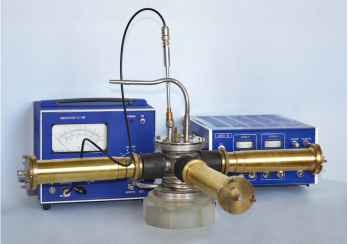SONOLUMINESCENT SETUP
Designation
The sonoluminescent system is used to study cavitation and cavitation-related phenomena by means of recording sonoluminescence, in other words - glowing, generated by the zone of cavitation.
The system is effective in studying of how the liquid properties and conditions of exposure to sound affect the cavitation growth dynamics; in assessing the cavitation activity under different conditions, in measuring the cavitation thresholds.
It is recommended for application in research projects aimed at identifying the mechanisms through which ultrasound and cavitation affect the biologic processes and organisms, chemical and physical processes in liquids.
Areas of application
Chemistry, sonochemistry; biology and medicine; acoustic cavitation physics
Technical specifications
| Embedded ultrasound emitter frequency |
22 kHz, 0,880 MHz 2,5 MHz |
| Process capacity volume, ml | 100…1000 |
| Generator power, W | 100 |
| Power output control range, % | 5…100 |
| Operating modes |
pulsed; continuous-wave |
| Generator dimensions, mm | 310x200x70 |
| Supply voltage, V; Hz | 220 ±10 %; 50 |
| Emitting surface diameter, mm | 12…20 |
| Converter material | piezoceramic |
| Sensitivity range of the photomultiplier, nm | 300…650 |
A range of system modifications can be made following the Customer’s technical requirements.
Operation principles
The system operating principle is based on recording and measuring the sonoluminescence intensity by the secondary emission cell.
The piezoceramic emitter converts electrical oscillations from the generator into elastic mechanical vibrations at a corresponding frequency. These elastic vibrations are transferred to the working medium (liquid) through a waveguide. The phenomenon, known as cavitation, being the formation and collapse of gas-vapor micro-bubbles, can be observed when the working liquid is exposed to ultrasound of substantial intensity (higher than some threshold value.
The zone of cavitation includes two types of bubbles:
- those continuously fluctuating with relatively small amplitude;
- those growing in the phase of negative pressure in the sound wave up to the size much bigger than their initial radius.
In the positive half-wave phase the latter compress at a high rate down to the sizes much smaller than their initial radius that is they collapse. As a result of fast compression the contents of the bubble is heating up to high temperatures (up to several thousands of degrees), causing glowing of the gas-vapor mixture inside bubbles, that is sonoluminescence.
Recording sonoluminescence and spectral responses of the cavitation noise allows evaluating the contribution of different types of cavitation into its resultant effect on the physico-chemical or biological processes under study.
Deliverable package
Ultrasonic generator – 1 piece.
Working container with embedded ultrasonic emitter – 1 piece.
Photomultiplier – 1 piece.
High-voltage power supply for the photomultiplier – 1 piece.
Hydrophone – 1 piece.
On Customer’s request the deliverable package can be completed with a wattmeter, oscilloscope and a cavitometer.
Delivery terms and conditions
The cavitometer delivery terms and conditions are set forth in the Delivery/Development Agreement.
The date when the «Product» is transferred to the Customer or his authorized carrier (in case, the express mail services are used) is considered the Product delivery date.
The « Product » is delivered in one batch within no more than 20 calendar days from the date the advanced payment arrives at the Contractor’s account.
Product warrantee liabilities
The guarantee service term is 12 months from the delivery date (as per the waybill).



